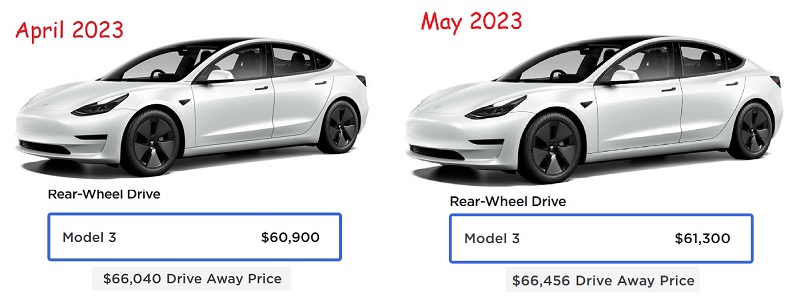
One month after lowering their EV prices in Australia, Tesla has bounced them up again and added $400 to all Model 3 and Model Y electric vehicles.
At today’s exchange rate, this is slightly higher than the $250US increase they’ve applied in America. I’m surprised at how Tesla treats their prices like a yo-yo and yanks them up and down like this. You’d think they would have saved themselves some trouble and simply cut their electric car prices less at the start of April.
Here are the base prices, including GST, for all the Tesla EVs their Australian site gives prices for. (They don’t want to tell me how much a Model S is.) I’ve also included the on-road cost in NSW, as that’s the most populous state:
- Model 3 Rear Wheel Drive: $61,300 On-road NSW: $66,456
- Model 3 Long Range: $74,300 On-road NSW: $79,976
- Model 3 Performance: $87,300 On-road NSW: $94,803
- Model Y Rear Wheel Drive: $69,300 On-road NSW: $74,776
- Model Y Long Range: $82,300 On-road NSW: $88,296
- Model Y Performance: $95,300 On-road NSW: $105,619

What a difference a month makes! Drive away price is for NSW.
Extras Cost Extra
The above prices don’t include any “extras”. Just getting a paint colour that is not as boring as standard off-white costs an extra $1,500, while red will set you back an extra $2,400. You can also pay an extra $1,800 for 20-inch wheels that are apparently worse. But the real kicker is asking $10,100 for “Full Self-Driving Capability”. This is because its name almost, but not quite, exactly describes what it isn’t. Thinking you can take a nap because you paid for “Full Self-Driving Capability” is a good way to find yourself taking a dirt nap. If they just called it “Driver Assist — That Some People Really Like For Some Reason — But Which Definitely Can’t Fully Drive The Car For You And You Have To Watch It Like A Hawk”, I’d have no problem with it. They could call it their “Driver Assist — TSPRLFSR — BWDCFDTCFYAYHTWILAH system” for short.
Note that if any extras bring the cost of the vehicle over the Luxury Car Tax threshold, which is currently $84,916 for EVs, you’ll have to pay 33% tax on the amount over it.
Not A Toyota Camry Dummy Spit
I have no idea why Tesla is hiking EV prices now when the cost of raw materials used to produce them is now falling. Maybe it’s a reaction to poor first-quarter figures and they’re hoping higher prices will help. They may also try to train people not to hold out for further price rises by showing they can increase. But whatever the reason, I’m certain it’s not because they’re spitting the dummy after the Model 3 failed to become an Australian best seller last year.
When I first heard Tesla had raised EV prices, I wondered if it was because they had given up on trying to beat the Toyota Camry as the nation’s best-selling mid-sized sedan. But then I found out the price rise was across the board, and what Tesla charges for the Model 3 Rear Wheel Drive is still roughly $4,000 less than in the US — before taxes or incentives are included. So it looks like Tesla is still out to beat the Camry. The odds look good they’ll manage it this year.

 RSS - Posts
RSS - Posts



Tesla are a disruptor. They do not care in the slightest what other car makers are doing.
If they are adjusting prices it’s supply and demand to suit their manufacturing process.
I ordered a Tesla in September. They dropped the price and adjusted my order by nearly 4k. Then they threw in a charger. Then they took the charger away. Tesla work in strange ways.
I just wish the ports would process my car which has been bobbing off the Sunshine cost for a week and a half now!
What is the difference between a Tesla and a Toyota Camry? One will never break down and has a great warranty and the other has suspect quality and an 80,000km warranty on everything except the battery. (you can purchase an “extended” warranty !) Given thatTesla is full of electronics and cameras inside to spy on your driving and other habits a second hand Camry with battery/petrol looks like a bargain to me.
I’m in Europe at present where it costs almost as much to charge as petrol on the highway chargers. Most people live in apartments so cannot charge at home.
Tesla’s Model 3 and Model Y Rear Wheel Drive battery warranties are for eight years or 160,000km. Whichever comes first.
Just incorrect. For a start the China made Teslas we get here have excellent build quality. The Toyota Camry “might” last a long while if you get it serviced regularly and you’re lucky. But actually they are built to be obsolete in 10 – 15 years because Toyota wants you to buy a new vehicle every 6 or 7 years. Tesla was the first manufacturer and one of the few that offers OTA updates that actually keep your vehicle relevant and up to date. Toyota hates this trend. They spend millions every year lobbying against EVs.
Basically Toyota and Tesla have diametrically opposed views on vehicle obsolesence.
$66.5 K on the cheapest Tesla , I could think many cars that I would buy for much cheaper and better value .
I’ve driven the lowest cost Tesla Model 3 and I’d take it over any new petrol or diesel burner in its price range. But… (wait for it)… your mileage may vary.
Mine concern ( and probably most of Australia ) is the Government talk of phasing out Petrol and Diesel Vehicles and we are made to buy EV , Most of Australia I’m sure cannot afford an EV at $65 K
EVs are far simpler than conventional cars. When mass produced an EV costs thousands less to make – not counting the battery pack. And battery packs are getting cheaper. If the sale of standard ICE vehicles is banned in 2035 like Japan or 2040 like New Zealand, electric cars then will be as cheap or cheaper than current cars and come with the benefit of lower running costs.
Hopefully, and thank you
My concern is that with governments rushing headlong to ban ICE vehicles how will we be building our roads in the future?
If we are going to pump the oil out of the ground, get the asphalt out of it and pump the rest back underground then roads are going to become mighty expensive.
Also I find it funny that governments are falling over themselves to ban ICE vehicles but no country has banned coal burning, gas burning for electricity, bunker oil burning for ships, jet fuel burning for jets, etc.
The cynic in me thinks that’s because forcing everyone into EVs is mostly a personal expense (and thus becomes corporate profits) but banning coal, gas, bunker oil, jet fuel, etc are corporate expenses that affect the politicians donors!
Value is subjective. When you look at what you actually get with a Tesla it’s more comparable with a BMW than a Camry. Take one for a test drive and then see if you can still get a comparable vehicle for less money.
“Just getting a paint colour as boring as the standard off-white costs an extra $1,500” bit of a mistake there Ronald. The pear whit multicoat is included in the base price.
Well spotted – there was a ‘not’ missing. Fixed.